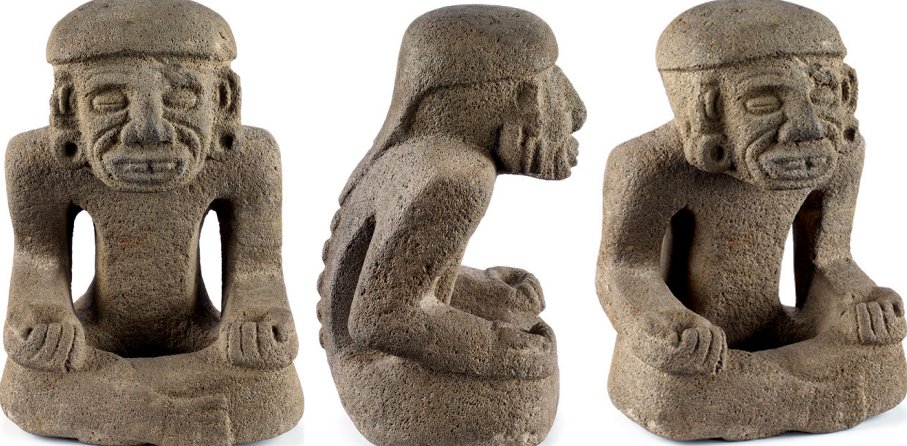Huehueteotl: Old Aztec God Of Fire, Time And Aging – Ceremony Of The New Fire
A. Sutherland - AncientPages.com - Huehueteotl may be one of the earliest gods in the Aztec mythology, but he was not added the Aztec pantheon, until these people arrived in the Valley of Mexico.
He is a Mesoamerican deity worshiped among pre-Columbian cultures, mainly in Aztec mythology and others who inhabited the Central Mexico region.
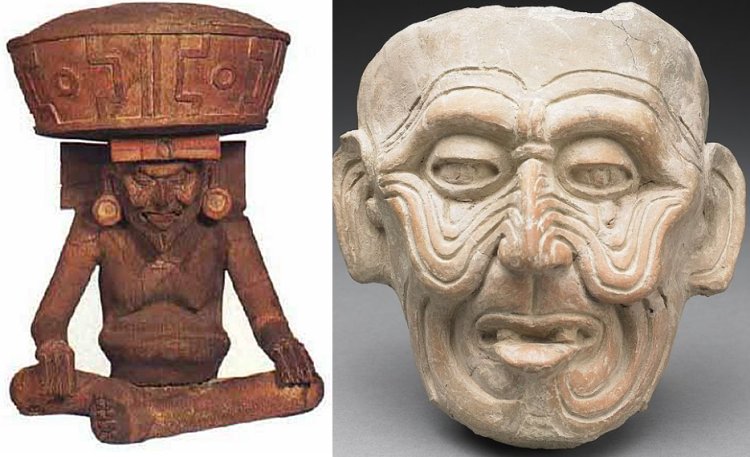
Left: Statue of Huehueteotl (Museo Nacional de Antropología, Mexico City; Right: Head of Old God, Huehueteotl. Image credit: Birmingham Museum of Art
In the Aztec ancient beliefs, it was Huehueteotl, who kept time in harmony and balance.
Name of Huehueteotl means: "old" (in Nahuatl: huēhueh) and "god" (teōtl). It is believed this god is associated with the Old God known as ‘Mam’ ("Grandfather") in beliefs of ancient Maya.
The deity originates in times before the rise of one of the oldest cities of Mexico - Teotihuacán. Ancient sources say that Huehuetéotl was already worshiped in the old town of Cuicuilco that was once a significant ancient site in the southeastern Valley of Mexico but in 50 BC, it was destroyed and abandoned.
From there, his cult spread to Teotihuacán, which was confirmed by discoveries of clay statues of this deity, depicting him as a bent old man sitting cross-legged and carrying a strange vessel on his head.
Significance Of Huehueteotl In Relation To Fire
For the Aztecs, fire was of great importance. In the Aztec religion, Huehueteotl supervised the domestic hearth fire of the household. A hearth has always been an important place for families in many ancient cultures around the world, including the Aztecs.
The hearth functioned when it was fire in it. But to the Aztecs, fire was also a symbol of change and renewal.
See also:
Fire – Powerful Symbol That Played A Key Role In History Of Mankind
Teotihuacán: Enigmatic Birthplace Of The Gods And Its Obscure History
Cuicuilco Circular Pyramid: Ancient Astronomical Observatory And Place Of Power
Florentine Codex: Remarkable Manuscripts About Life Of The Aztecs
Many images of Huehueteotl were unearthed in ruins of residential quarters of the Aztec people but not in temples.
Depictions Of Huehueteotl And Similar Attributes With Xiutecuhtli
Huehueteotl symbolizes the keeping of time and aging. He is usually depicted as an aged or even crumbling being, often with a beard. Another god known as Xiutecuhtli, has very similar attributes to Huehueteotl but is portrayed as a young and dynamic man. Xiutecuhtli is a god of fire, day and heat and rules over volcanoes. He symbolizes warmth in cold (fire) and light in darkness.
Of all the Aztec deities, the god of fire and the heat of the earth, Huehueteotl ('old', 'old god'), is probably the one whose origin is the oldest. The grandfather of the pantheon, his seniority is indicated by the wrinkles that cover his face, the two teeth and the curvature of his spine. Huehueteotlof is depicted sitting cross-legged, his hands are resting on his knees. Image credit: MEG
It is unclear whether these two deities represent two different mythological figures or perhaps only one. Do these two deities symbolize transformation of young into old?
The Florentine Codex is most probably the best known of the many codices dealing with the Aztecs. This codex identifies Huehueteotl as an alternate epithet for Xiutecuhtli, and therefore that deity is occasionally referred to as Xiutecuhtli-Huehueteotl.
Ceremony Of The New Fire
It is known that the Ceremony of the New Fire was dedicated to Huehueteotl and it took place at the end of every 52 year calendar cycles.
During the ritual of New Fire, all fires through-out the land were extinguished and the entire Aztec population was plunged into darkness. Priests would watch the movement of the stars and look for the signal to tear out a sacrificial victim’s heart; then they would start a fire on the body and take it around to all homes in the area. This ritual replicated the way in which Aztecs believed the gods first created fire and postponed the end of the world.
Written by – A. Sutherland - AncientPages.com Senior Staff Writer
Copyright © AncientPages.com All rights reserved. This material may not be published, broadcast, rewritten or redistributed in whole or part without the express written permission of AncientPages.com
Expand for referencesReferences:
Susan Toby Evans, David L. Webster, Archaeology of Ancient Mexico and Central America
Ryan, Duncan. The Aztec
More From Ancient Pages
-
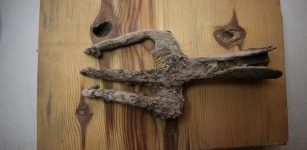 1700-Year-Old Iron Trident Found In The Ancient City Of Assos, Turkey
Archaeology | Nov 1, 2023
1700-Year-Old Iron Trident Found In The Ancient City Of Assos, Turkey
Archaeology | Nov 1, 2023 -
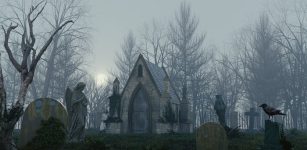 Strange Tale Of Demonic Possession And Exorcism In 17th-Century New France – What Happened?
Featured Stories | Oct 21, 2022
Strange Tale Of Demonic Possession And Exorcism In 17th-Century New France – What Happened?
Featured Stories | Oct 21, 2022 -
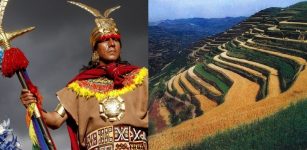 Terrace Farming Was Invented In South American Andes Over 1,000 Years Ago
Ancient History Facts | Sep 7, 2016
Terrace Farming Was Invented In South American Andes Over 1,000 Years Ago
Ancient History Facts | Sep 7, 2016 -
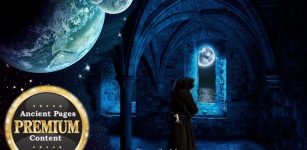 Unknown Holographic Technology Hidden In Old Monastery Reveals A Surprising Secret
Featured Stories | Dec 7, 2018
Unknown Holographic Technology Hidden In Old Monastery Reveals A Surprising Secret
Featured Stories | Dec 7, 2018 -
 Did Ancient Oshoro Stone Circle Serve As A Portal To The Spirit World?
Featured Stories | Aug 19, 2017
Did Ancient Oshoro Stone Circle Serve As A Portal To The Spirit World?
Featured Stories | Aug 19, 2017 -
 Charles VI Of France – The King Who Was Made Of Glass
Featured Stories | Jan 22, 2016
Charles VI Of France – The King Who Was Made Of Glass
Featured Stories | Jan 22, 2016 -
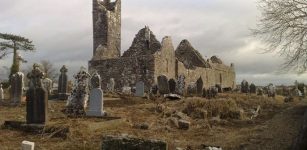 Surprising Discovery Reveals Why Medieval Graves Were Re-Opened – Stealing Was Not The Purpose
Archaeology | May 24, 2017
Surprising Discovery Reveals Why Medieval Graves Were Re-Opened – Stealing Was Not The Purpose
Archaeology | May 24, 2017 -
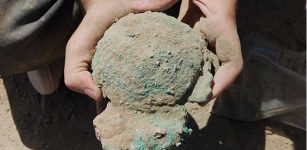 Rare Discovery Of 4,300-Year-Old Copper Ingots Left By Mistake In A Settlement In Oman
Archaeology | Jun 2, 2023
Rare Discovery Of 4,300-Year-Old Copper Ingots Left By Mistake In A Settlement In Oman
Archaeology | Jun 2, 2023 -
 Ashvins: Vedic Twin Gods Of Medicine And Healing Were Skilled Surgeons
Featured Stories | Feb 1, 2019
Ashvins: Vedic Twin Gods Of Medicine And Healing Were Skilled Surgeons
Featured Stories | Feb 1, 2019 -
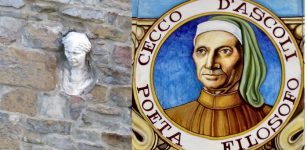 Mysterious La Berta – ‘Petrified’ Stone Head And The Curse Of Cecco d’Ascoli Who Was Burned At The Stake
Featured Stories | Jul 29, 2019
Mysterious La Berta – ‘Petrified’ Stone Head And The Curse Of Cecco d’Ascoli Who Was Burned At The Stake
Featured Stories | Jul 29, 2019 -
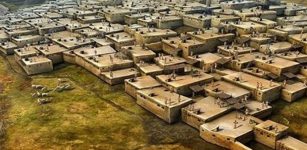 8000-Year-Old Prehistoric Çatalhöyük: Residents Were Buried In Their Homes
Archaeology | May 1, 2020
8000-Year-Old Prehistoric Çatalhöyük: Residents Were Buried In Their Homes
Archaeology | May 1, 2020 -
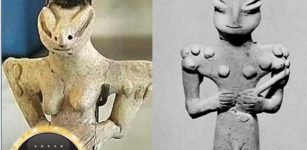 Ancient Reptilian-Like Humanoids Hold Secrets Of Mankind’s Origin
Artifacts | Apr 12, 2014
Ancient Reptilian-Like Humanoids Hold Secrets Of Mankind’s Origin
Artifacts | Apr 12, 2014 -
 Intriguing Genetics: First Ancient Irish Human Genomes – Sequenced
Archaeology | Dec 29, 2015
Intriguing Genetics: First Ancient Irish Human Genomes – Sequenced
Archaeology | Dec 29, 2015 -
 Uncovering 16th Century Scottish Royal Dockyards Used By King James IV’s Navy
Archaeology | May 24, 2018
Uncovering 16th Century Scottish Royal Dockyards Used By King James IV’s Navy
Archaeology | May 24, 2018 -
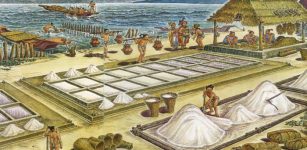 Ancient Maya Saltworks: Salt Was A Commodity Or Money In Classic Maya Economy
Archaeology | Mar 23, 2021
Ancient Maya Saltworks: Salt Was A Commodity Or Money In Classic Maya Economy
Archaeology | Mar 23, 2021 -
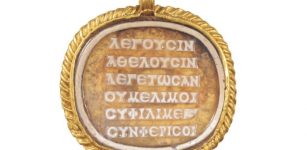 Almost Unknown Ancient Greek Text Rewrites History Of Poetry And Song
Archaeology | Sep 9, 2021
Almost Unknown Ancient Greek Text Rewrites History Of Poetry And Song
Archaeology | Sep 9, 2021 -
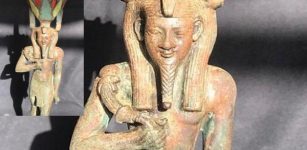 Carved Statue Of God Nefertum Unearthed In Egypt’s Saqqara Necropolis
Archaeology | Oct 3, 2020
Carved Statue Of God Nefertum Unearthed In Egypt’s Saqqara Necropolis
Archaeology | Oct 3, 2020 -
 Unknown 500,000-Year-Old Migration Route Of Homo Erectus From Africa – Discovered
Archaeology | May 10, 2019
Unknown 500,000-Year-Old Migration Route Of Homo Erectus From Africa – Discovered
Archaeology | May 10, 2019 -
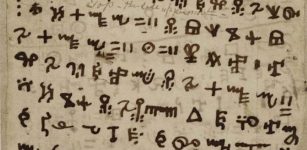 Vai Script – Rare African Manuscript Offers Clues Into How Writing Evolved
Archaeology | Jan 11, 2022
Vai Script – Rare African Manuscript Offers Clues Into How Writing Evolved
Archaeology | Jan 11, 2022 -
 Mysterious Manuscript 512 Reveals Lost Ancient City Hidden In The Amazon Jungle
Featured Stories | Jan 28, 2018
Mysterious Manuscript 512 Reveals Lost Ancient City Hidden In The Amazon Jungle
Featured Stories | Jan 28, 2018

